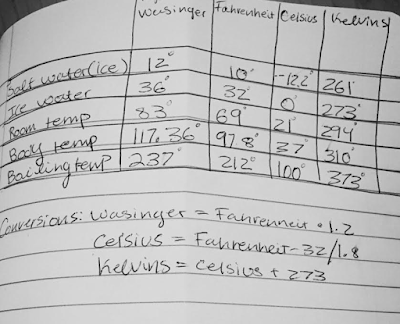Finding the Mole
With Lab Partners: Eri M. and Melanie F.
Purpose:
To observe reactions that form solids and to take note of the amount of product formed by different ratios of reactants.
Procedure:
Part I
- Firstly, label 5 test tubes with tape numbering them 1 through 5
- Regard the table below and add appropriate amounts of .10 M CaCl2 (aq) Calcium chloride and .10 M Na2CO3 (aq) Sodium carbonate.
- Swirl the test tube to mix reactants. Set the test tubes on the test rack and allow for the solid forming to sink to the bottom of the tube (about 10 minutes). While the solids are settling, start on Part II of the experiment.
- Finish the experiment after the solids have settled by measuring and recording the height of the solid in the test tube,
- Table of amounts for each test tube + height:
- Test Tube 1 2 3 4 5
- mL of CaCl2 4 6 12 18 20
- mL of Na2CO3 20 18 12 6 4
- Ratio: CaCl2 to Na2CO3= 1:5 1:3 1:1 3:1 5:1
 Post-swirl
Post-swirl
Part II
- Label 5 test tubes 6 through 10
- Regard the table below and add appropriate amounts of . 10 M CuSO4 (aq) Copper (II) Sulfate and .10 M NaOH (aq) Sodium Hydroxide.
- Swirl the test tube to mix reactants. Set the test tubes on the test rack and allow for the solid forming to sink to the bottom of the tube (about 10 minutes). While the solids are settling, start on Part II of the experiment.
- Finish the experiment once the solid has settled at the bottom of the test tube by measuring and recording the height of the solid in the test tube.
- Table of amounts for each test tube + height:
- Test Tube 6 7 8 9 10
- mL of CuSO4 4 8 12 16 20
- mL of NaOH 20 16 12 8 4
- Ratio: CuSO4 to NaOH= 1:4 1:2 1:1 2:1 4:1
The settled solid in the test tubes at the end of Part II
CaCl2 (aq) + Na2CO3 (aq) -> CaCO3(aq) + 2NaCl2(s)
CuSO4 + 2NaOH -> Na2SO4 (s) + Cu(OH)2 (aq)
By limiting reactants and using ratios of each reactant, the amount of solid produced is also limited.
Materials
- 12 x 75 mm test tubes (10)
- Test tube rack
- Marker and tape to label test tubes
- Pipette
- 60 mL of .10 M CaCl2 (aq) Calcium Chloride
- 60 mL of .10 M Na2CO3 (aq) Sodium Carbonate
- 60 mL of .10 M CuSO4 (aq) Copper (II) sulfate
- 60 mL of .10 M NaOH (aq) Sodium Hydroxide
CaCl2 (aq), irratant to skin, eyes, and if ingested or inhaled. Can permeate skin and harmful (Scienelab.com Clacium chloride).
Na2CO3 (aq) Hazardous, irritant to skin and eyes. Poisonous if swallowed (Scholar chemistry)
CuSO4(aq) Irratant to skin, eyes and respiratory system. Hazardous if ingested/inhaled. (TMC)
NaOH (aq) Irratant, corrosive and permeator to skin. Harmful if ingested/inhaled. Corrosive, irritant to eyes (Sciencelab.com Sodium Hydroxide).
Hypothesis
Based upon the equation for part I: CaCl2 (aq) + Na2CO3 (aq) -> CaCO3(aq) + 2NaCl2(s) , the most solid will be produced when CaCl2 and Na2CO3 are at a ratio of 4:1 in the test tube. For Part II, the most solid wil appear in the tube with a ratio of 1:4 for CuSO4 to 2NaOH.
Data
Part I
Test Tube: 1 2 3 4 5
Height of solid 0.2 0.4 0.3 1.1 1.0
(in Centimeters)
Part II
Test Tube: 6 7 8 9 10
Height of solid 1.1 0.9 0.7 0.3 0.2
(In Centimeters)
Calculations/ Analysis
In this lab, for part I, the ratio that produced the largest amount of solid was the 4:1 ratio of CaCl2 to Na2CO3
For part II, the ratio with the greatest amount of solid was the 1:4 ratio of CuSO4 to NaOH
The hypothesis is supported because in the experiment for both part I and II showed that higher amounts of solid were produced at the predicted ratios (4:1 for part I and 1:4 for part II)
Graphs
Conclusion
The Hypothesis was supported in that the most solid appeared in the tube containing a 4:1 ratio in part I and a 1:4 ratio in part II
Discussion of Error
Error in this lab could be due to that in the act of swirling the test tube, some of the matter in the test tube was lost.
Citations
Sciencelab.com. Chemicals and laboratory equipment. (5/21/2013). Material Safety Data Sheet: Calcium chloride anhydrous MSDS. http://www.sciencelab.com/msds.php?msdsId=9923251
Scienelab.com Chemicals and laboratory equipment (5/21/2013). Material safety data sheet: Sodium hydroxide. http://www.sciencelab.com/msds.php?msdsId=9924997
Scholar Chemistry (9/22/2012). Material Safety data sheet. http://www.scholarchemistry.com/msds/Sodium_Carbonate_Solution_1.0M_648.10.pdf
TMC. Material data safety sheet. (Feb.13. 2003). http://tmc.co.kr/home/link/Microsoft%20Word%20-%201-2-2-2-15MSDS%20_copper%20sulfate%20Pentahydrate_.pdf
Citations
Sciencelab.com. Chemicals and laboratory equipment. (5/21/2013). Material Safety Data Sheet: Calcium chloride anhydrous MSDS. http://www.sciencelab.com/msds.php?msdsId=9923251
Scienelab.com Chemicals and laboratory equipment (5/21/2013). Material safety data sheet: Sodium hydroxide. http://www.sciencelab.com/msds.php?msdsId=9924997
Scholar Chemistry (9/22/2012). Material Safety data sheet. http://www.scholarchemistry.com/msds/Sodium_Carbonate_Solution_1.0M_648.10.pdf
TMC. Material data safety sheet. (Feb.13. 2003). http://tmc.co.kr/home/link/Microsoft%20Word%20-%201-2-2-2-15MSDS%20_copper%20sulfate%20Pentahydrate_.pdf










